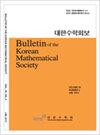关于与幂等有关的可逆性
IF 0.5
4区 数学
Q3 MATHEMATICS
引用次数: 2
摘要
本文讨论了环的一个性质,它保留了元素在非零幂等处的可逆性。如果0 6= ab∈I(R),对于A, b∈R意味着ba∈I(R),其中I(R)是R中所有幂等元的集合,则称环R是拟可逆的。我们研究了2 × 2满上三角矩阵环在各种可逆环上的拟可逆,得出拟可逆是可逆性的适当推广。证明了拟可逆性不传递到多项式环上。我们还观察了阿贝尔环的结构与可逆性和拟可逆性的关系。1. 除非另有说明,否则整个环都是具有恒等的结合环。设R是一个环。分别用I(R)、N * (R)、N(R)和J(R)表示R中所有幂等元的集合、上零根(即所有零理想的和)、所有幂零元素的集合和Jacobson根。注:N * (R)≥N(R)。写I(R) ' = {e∈I(R) | e6 = 0}。Z(R)表示R的中心,x在R上不确定的多项式环记为R[x]。Z和Zn分别表示整数环和以n为模的整数环。设n≥2。用n × n表示。,上三角)矩阵环除以R乘以Matn(R) (p。、Tn (R))和Dn (R) = {(aij)∈Tn (R) | a11 = · · · = 安}。用Eij表示(i, j)项为1的矩阵,其他地方为零,In表示Matn(R)中的单位矩阵。在Cohn[4]之后,如果ab = 0对于a, b∈R意味着ba = 0,则环R(可能没有单位元)称为可逆的。安德森和卡米洛用ZC2来表示可逆性。一个环(可能没有单位元)如果没有非零的幂零元,通常被认为是约简的。许多交换环是不约化的(例如,对于n, l≥2,Znl),并且存在许多非交换约化环(例如,非交换域的直积)。很容易检查到可逆环类包含交换环。2018年11月6日修订;2018年11月21日录用。2010数学学科分类。16U80, 16S36, 16S50。本文章由计算机程序翻译,如有差异,请以英文原文为准。
ON REVERSIBILITY RELATED TO IDEMPOTENTS
This article concerns a ring property which preserves the reversibility of elements at nonzero idempotents. A ring R shall be said to be quasi-reversible if 0 6= ab ∈ I(R) for a, b ∈ R implies ba ∈ I(R), where I(R) is the set of all idempotents in R. We investigate the quasireversibility of 2 by 2 full and upper triangular matrix rings over various kinds of reversible rings, concluding that the quasi-reversibility is a proper generalization of the reversibility. It is shown that the quasi-reversibility does not pass to polynomial rings. The structure of Abelian rings is also observed in relation with reversibility and quasi-reversibility. 1. Quasi-reversible rings Throughout every ring is an associative ring with identity unless otherwise stated. Let R be a ring. Use I(R), N∗(R), N(R), and J(R) to denote the set of all idempotents, the upper nilradical (i.e., the sum of all nil ideals), the set of all nilpotent elements, and the Jacobson radical in R, respectively. Note N∗(R) ⊆ N(R). Write I(R)′ = {e ∈ I(R) | e 6= 0}. Z(R) denotes the center of R. The polynomial ring with an indeterminate x over R is denoted by R[x]. Z and Zn denote the ring of integers and the ring of integers modulo n, respectively. Let n ≥ 2. Denote the n by n full (resp., upper triangular) matrix ring over R by Matn(R) (resp., Tn(R)), and Dn(R) = {(aij) ∈ Tn(R) | a11 = · · · = ann}. Use Eij for the matrix with (i, j)-entry 1 and zeros elsewhere, and In denotes the identity matrix in Matn(R). Following Cohn [4], a ring R (possibly without identity) is called reversible if ab = 0 for a, b ∈ R implies ba = 0. Anderson and Camillo [1] used the term ZC2 for the reversibility. A ring (possibly without identity) is usually said to be reduced if it has no nonzero nilpotent elements. Many commutative rings are not reduced (e.g., Znl for n, l ≥ 2), and there exist many noncommutative reduced rings (e.g., direct products of noncommutative domains). It is easily checked that the class of reversible rings contains commutative rings Received August 14, 2018; Revised November 6, 2018; Accepted November 21, 2018. 2010 Mathematics Subject Classification. 16U80, 16S36, 16S50.
求助全文
通过发布文献求助,成功后即可免费获取论文全文。
去求助
来源期刊
CiteScore
0.80
自引率
20.00%
发文量
0
审稿时长
6 months
期刊介绍:
This journal endeavors to publish significant research of broad interests in pure and applied mathematics. One volume is published each year, and each volume consists of six issues (January, March, May, July, September, November).

 求助内容:
求助内容: 应助结果提醒方式:
应助结果提醒方式:


